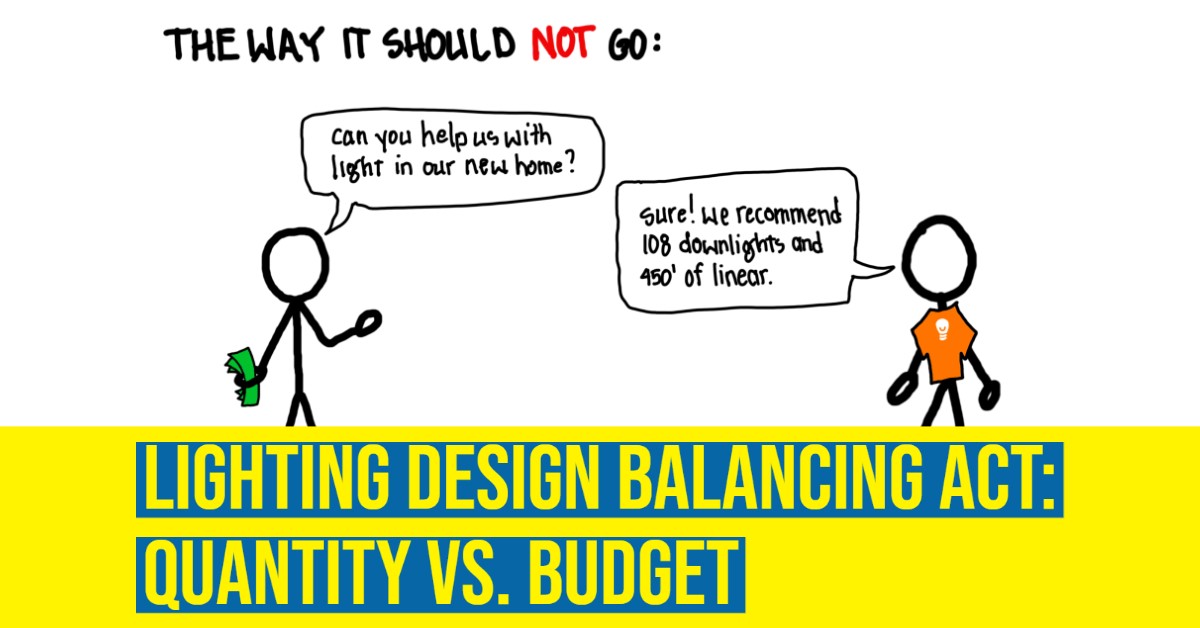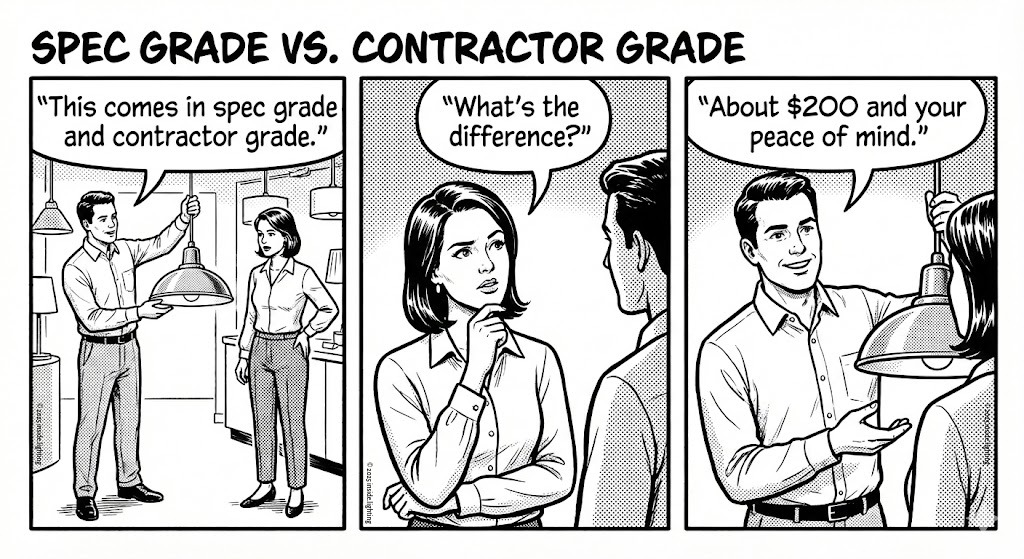October 13, 2022
Lighting Design Balancing Act: Quantity vs. Budget
Author: David Warfel, Light Can Help You
David Warfel explains why really good lighting can't be delivered for the same price as really bad lighting

Budget conversations are my least favorite part of the lighting design process, though I have learned to dive right in rather than soft-pedal the costs and cause everyone bigger headaches down the road. The simple (unfortunate) truth is that really good lighting cannot be delivered for the same price as really bad lighting.
Complicating the budget decision is the occasional client who mistakes their budget needs as expertise on lighting. Imagine, if you will, the conversation with builder going something like above, where the builder provides a cost for the home and a detailed quantity of something absolutely essential to the process, like two-by-fours. These sticks of wood hold up houses, frame out soffits, provide backing for wall cabinets, reinforce floors, and so many other critical functions in a home (please allow me to use 2×4 as a generic term for framing lumber…there are a lot of different sizes that make up a real home).
Quite simply, there are very few clients out there who can look at a quantity of lumber and determine whether or not it will build what they want and be safe, functional, and beautiful. I certainly could not. But that doesn’t stop some of us from trying to become the framing expert, so to speak, and suggest the builder do with less.

In this fictional conversation, the client has an emotional or practical reaction to the cost of the home and suggests to the builder that they have quoted too many 2×4’s. Can you use less, to get within my budget?
A decent builder is going to say no, because removing 2×4’s from the house would remove features, make walls less stable, and so on. The finished product would not be as beautiful and would most likely be unsafe as well. The conversation above seems silly.
But our clients are the experts of their needs and – significantly for this conversation – their bank account balance. They know what they can afford, and for builders or lighting designers to ignore this reality is to cause unnecessary pain for everyone involved.

A better budget approach- and fortunately the common approach- is for a builder to provide an estimate of the total cost for a new home. The client can look at the number (and not be distracted by the quantity of 2×4’s) and determine whether or not it fits their budget.

If the budget is more than the client wants to spend, they can ask the builder how to save some money. The builder then recommends ways to cut costs such as building smaller, trimming finishing material costs, or letting go of that second fireplace in the master bedroom.
But for some reason, lighting design seems to get caught up in the quantity discussion from time to time.

So let’s imagine the conversation again, this time with a lighting designer instead of a builder. The client asks for help with lighting, and the designer provides a quantity of fixtures and a budget price.

The client needs to reduce the budget, so they ask the lighting designer to reduce the number of 2×4’s, er, recessed downlights or other fixtures. The lighting designer, like the builder tasked with using fewer 2×4’s, struggles to answer because often they simply cannot deliver what the client wants or needs with random reductions. The result would not be as beautiful, and may not even be as safe.
It is worth mentioning that lighting designers are often consultants to architects or collaborators with interior designers and builders. In this case, the builder or designer may also play the role of the client. “I need you to cut 20% of the downlights, there are too many.”

We can learn something from the builder conversation at the beginning of this post. A client can ask for lighting, and the lighting designer can make a recommendation.

The client then evaluates the budget against their bank account and, if needed, requests suggestions for reducing the budget. The lighting designer then uses their expertise to recommend options to reach the client’s budget.
This could be reducing the number of recessed downlights, but it is more likely to be a strategic mix of fixture reduction, lower-priced fixtures, and even completely new design concepts that rely on fewer dollars. It is even conceivable that the cost-saving solutions proposed by a lighting designer might include an increase in fixtures, but of lower overall cost. The point is that the lighting expert, the lighting designer, is best suited to recommend cost-saving methods.
The budget conversation for a home is complicated and uncomfortable for almost everyone involved. If it gets bogged down in a discussion of the quantity of 2×4’s or downlights, the results can be less comfortable and even unsafe. Let the lighting designer be the lighting expert and recommend cost-saving solutions if the budget estimate is too high.
And lighting designers, remember to let the client be the expert on their bank account. The end results will make everyone happier.
Follow David Warfel’s Language of Light blog »
About the Author:
David Warfel is an overly sensitive, marginally materialistic, pseudo-tree-hugging Midwestern farm boy turned lighting designer, educator, author, and entrepreneur. He’s been either lucky or talented enough to land design opportunities in residential, hospitality, museum, commercial, and even the super-niche escape-rooms-on-giant-cruise-ships industry. When he isn’t boring someone to tears talking about lighting, David leads the quirky design business, Light Can Help You, into new frontiers in search of better lighting for more people.











